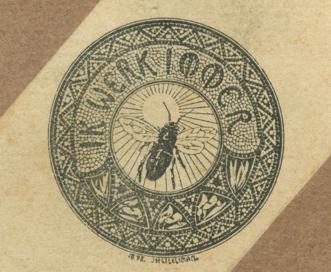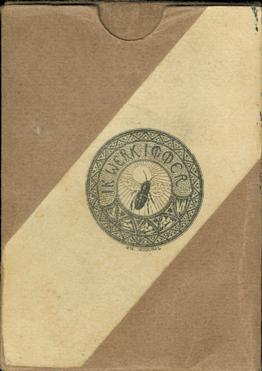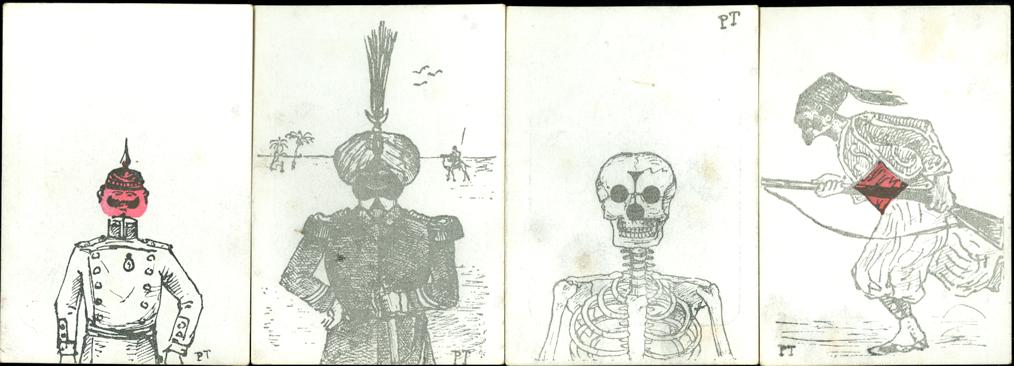December 2011
 |
We have
different reasons for buying standard patterned decks. This month we bought a
complete deck just for the joker (see the Joker of the Month) and another deck, just for
the Jack of Clubs. Lately Joop is interested in older decks with standard patterns, produced by
"foreign" manufacturers. In this case it was a deck with a standard
French pattern, but produced in Germany by Frommann & Morian around 1910. We
don't have a separate xpo (yet?) of interesting single cards, but Joop wanted to show this card
somewhere on our site and we decided to put it here as an extra intro, although the
card has nothing to do with the Deck of the Month. |
|
The German
manufacturer has followed the rules of the French pattern. The design
of the courts is close to the original Gatteaux double-imaged design from 1827, the deck has plain aces,
with a wrath around the suit sign on the ace of Clubs, and on the Jack of Clubs
the manufacturer's name can be found. It is printed along the side, just like
the name of their location, Darmstadt, along the opposite side. The shields
are interesting too. On one of the shields the company logo of Frommann
& Morian, an anchor, is put in the center, on the other the original
Gatteaux flower. The text on the rim refers to the French tax law of
1853, which is a bit odd, as the deck was published after 1890, in which
year a new French tax law was installed. For this law a stamp on
the ace of Clubs was used.
All together an unusual card, but... now the regular intro. |
The monthly flea market in Utrecht coincided with a playing cards
collectors meeting in Velddriel. Miriam had only just returned home and was
still too weak to come along, so Joop had to make a choice. He likes the hectic atmosphere
in the early hours of
the flea market, but the ambiance of the meeting place in Velddriel is very nice too and of course
the offer of decks at a collectors meeting is more reliable, in quantity as well
as in quality, than on a flea market. And..... he could get up about an hour
later. So..... Velddriel it was!
But that was the
only event that he attended this month and as he didn't bring home any decks
that would deserve a place here, the internet had to provide those. Ebay always has some
treasures in their vast offer, but although we bid generously this time, we
still ended up second in most of these auctions. We did win some remarkable
decks too, like a hard to find French doubledeck "Le Blocus de Napoleon" and
an antique French Tarot deck by Grimaud, with an unusual pattern on the courts
and Chinese people and weird sea creatures on the Arcana trumps. We don't
collect Tarots, but like to make the exception.
So there were some interesting decks on our shortlist, but we chose an
unusual and here unknown deck this month. It came from the Dutch auction site
and we only saw pictures of a few cards there. They didn't look familiar in any
way and we decided to go for it. For a change we worked around the official
bidding ourselves this time and it paid off. It wasn't a bargain, but at least
we brought it home and it's unusual enough to be presented here as Deck of the
Month.
|
There is
very little that we can tell you about this deck. The courts have
no indices and the pips no numbers. On the box there is a sort of logo,
with the words "ik werk immer" ( I work continuously). It is
done in a art nouveau style which was popular around 1900. The design is
signed by J.H.W. Leliman and dated 1898. As you will see, in this deck
there are other interesting cards, that also refer to an antique
style deck.
But we
thought that looks could be deceiving and |

|
we had read
the initials on the backs as DAS, a Dutch insurance company for legal assistance. This
Dutch branch of the originally French "Défense Automobile et
Sportive" was founded in 1963.
The courts
show a repeated design of three silhouettes taken from the Rhineland
pattern. We decided to take a look in a few of our different showcase
holders and see if we could find an exact matching shape of this pattern,
which could tell us the manufacturer, who had inspired the designer of
this deck.
|

But this
deck definitely doesn't have the quality of a Dondorf deck. It is
printed on thin card with a thin coating. And the quality of
printing isn't that good either.
When buying online you can't tell that from a few pictures. You only
have the shown cards to go by.
|
|
|
It didn't take long, as we decided to start with the
manufacturer, to whom this pattern was attributed. Et voilá.... the
silhouettes are an exact match to the figures in the Diamond suit of the
Rhineland pattern by B. Dondorf.

|
|

|
|
Now
that you can see the aces, you can imagine why we were so interested in
getting this deck. It had all the characteristics of a transformation deck,
but in the pictures in the ad we had already spotted
some irregularities. You'll see them too, when you click the aces to see
the pips. |
All the designs on
the pips and aces are signed P.T. We don't know that many antique transformation
decks, but some of these designs looked familiar, so we decided to check and see
if P.T. had also used existing transformation cards as inspiration. Of course we took
out the book about transformation playing cards by Albert Field, a longtime
collector of all kind of playing cards with -in his time- one of the largest
private collections and a connoisseur. To our surprise we found the deck
pictured there. From the text we gathered that Mr. Field didn't know that much
about this deck either. He did mention the origin of the court designs, which
was a pleasure to read, as we had just found that out by ourselves too. Although
he mentions the name and date of the design on the box, he doesn't give a date
in that text. But in the index the deck is mentioned as # 59 - 1898 Leliman.
Our quest for
information at the DAS company didn't bring any answers at all. Although there
was still an employee who had worked there for more than 25 years, there was no
recollection of a deck like this. So maybe we misinterpreted the initials and
should follow Mr. Field's conclusion about the date. It is supported by some of
the drawings. E.g. the German helmet was used around 1900 and the depicted
German (on the Ace and 8 of Hearts) looks a lot like Kaiser Wilhelm II, the
German emperor under whose regime WW I was initiated.


However, we had to look
hard to find a back on which the design is correctly centered. On most backs
it's off center. This, together with the poor material, the square corners and
low quality printing, points towards a small printing firm, not equipped for or
used to printing playing cards. And because there is a text in Dutch on some of
the cards, the deck was apparently published in the
Netherlands, maybe even by a Dutch printer.
The deck consists
of 52 cards. No joker was found, but probably wasn't issued with the deck. The box is made of thick brown paper, the yellowish band with the printed logo
of thin light brown paper and glued to the front of the box.
BACK TO PRESENT MONTH







